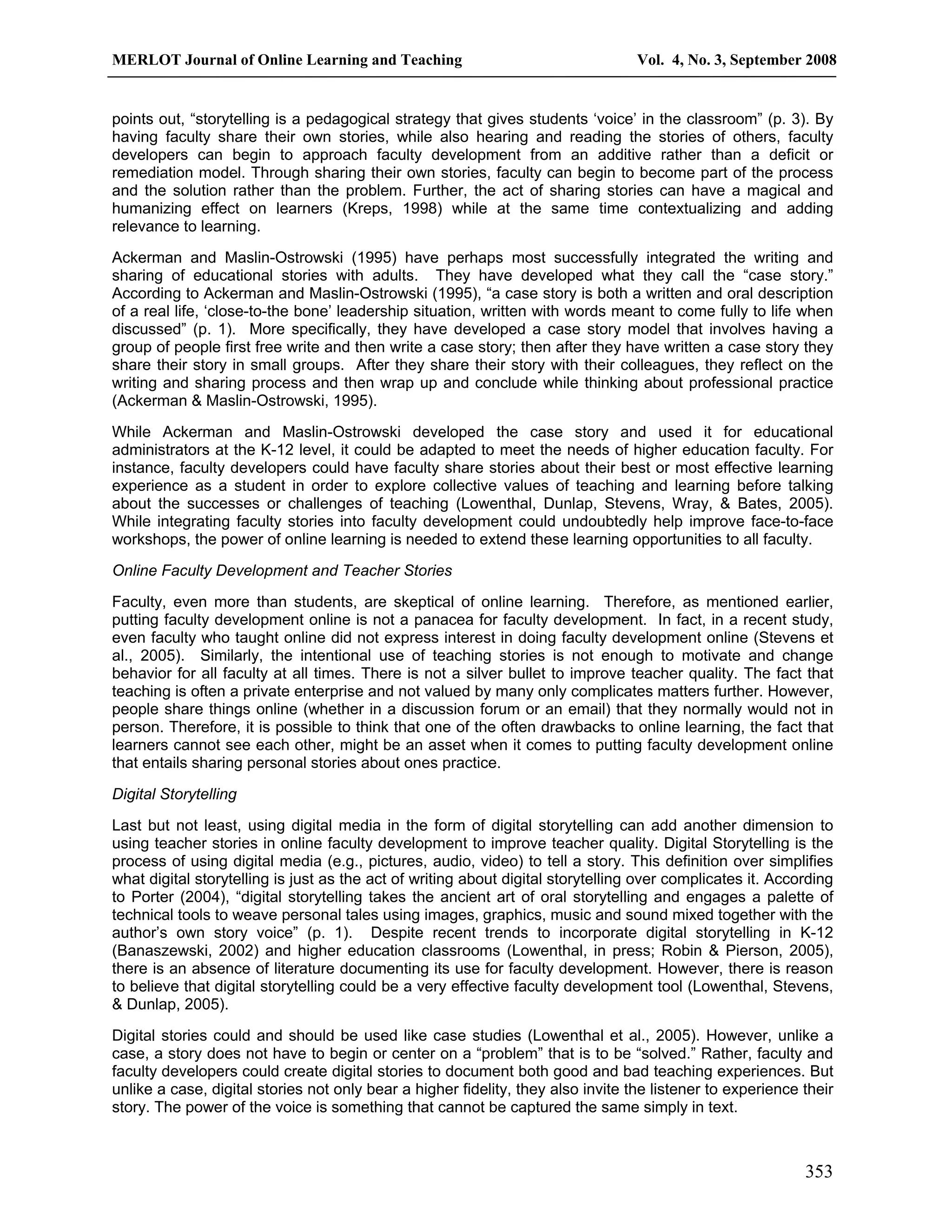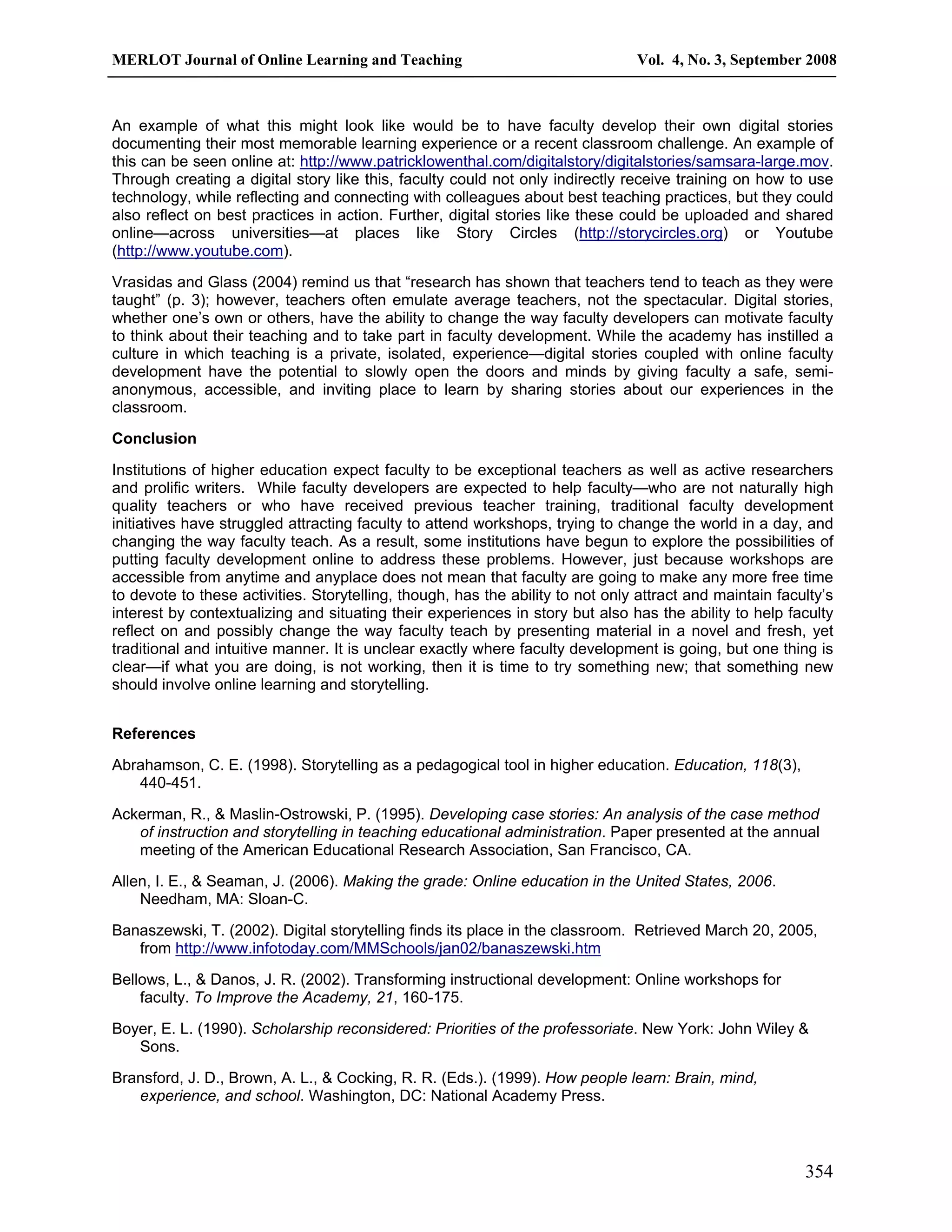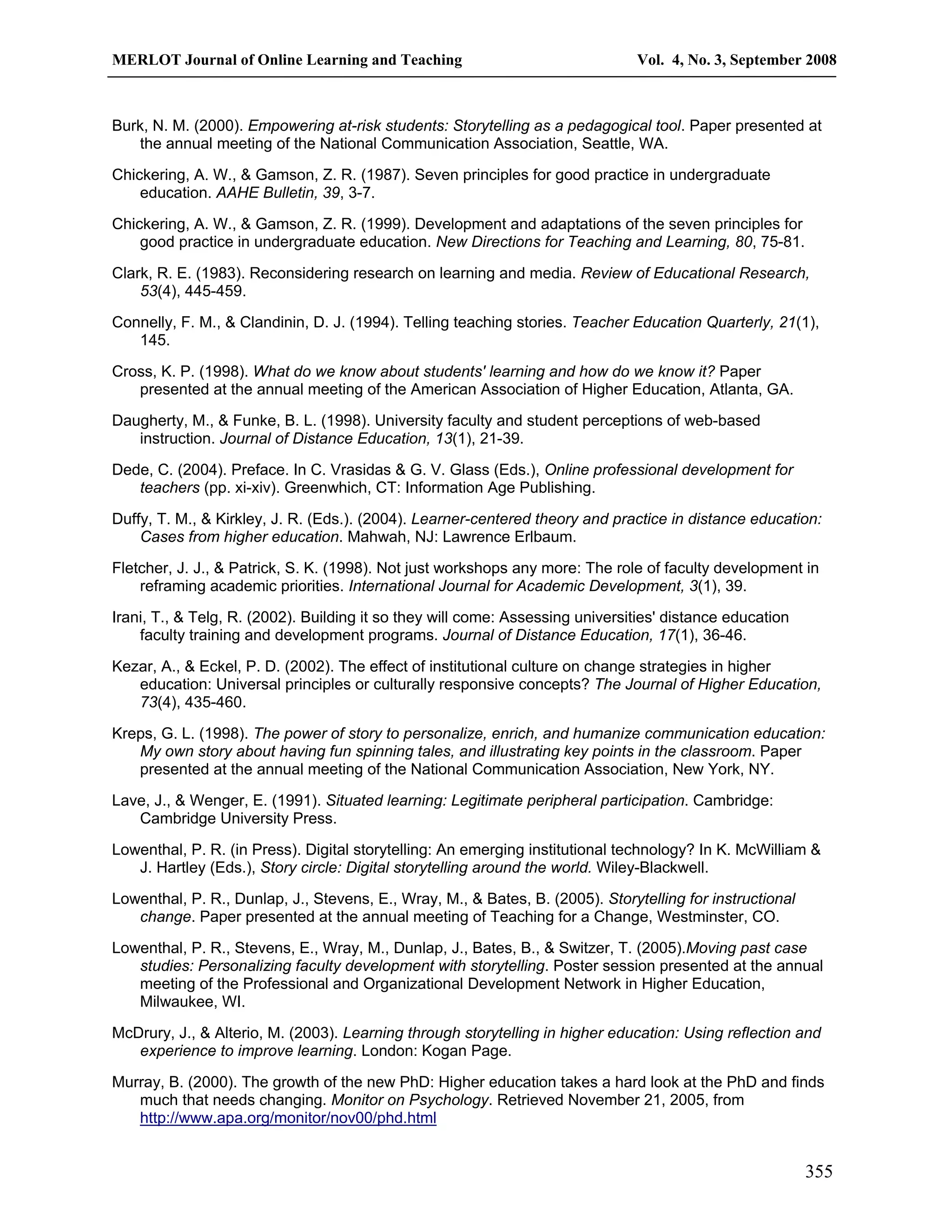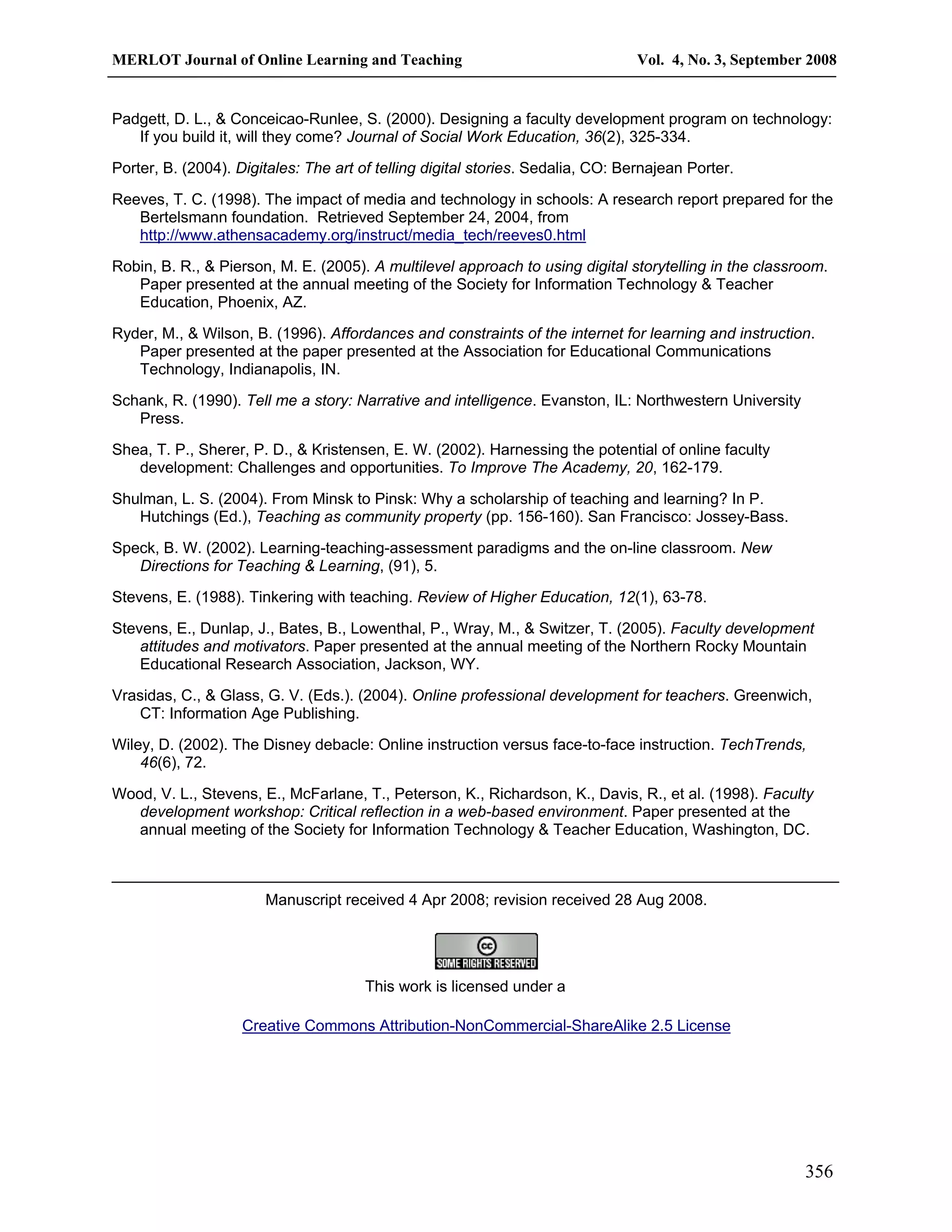The document discusses the need for improved faculty development in higher education to enhance teacher quality, highlighting that many faculty lack proper training. It argues for the integration of online learning and storytelling as innovative strategies to address deficiencies in traditional faculty development approaches. By leveraging these methods, institutions can create more engaging and relevant professional development opportunities that resonate with educators' experiences and needs.
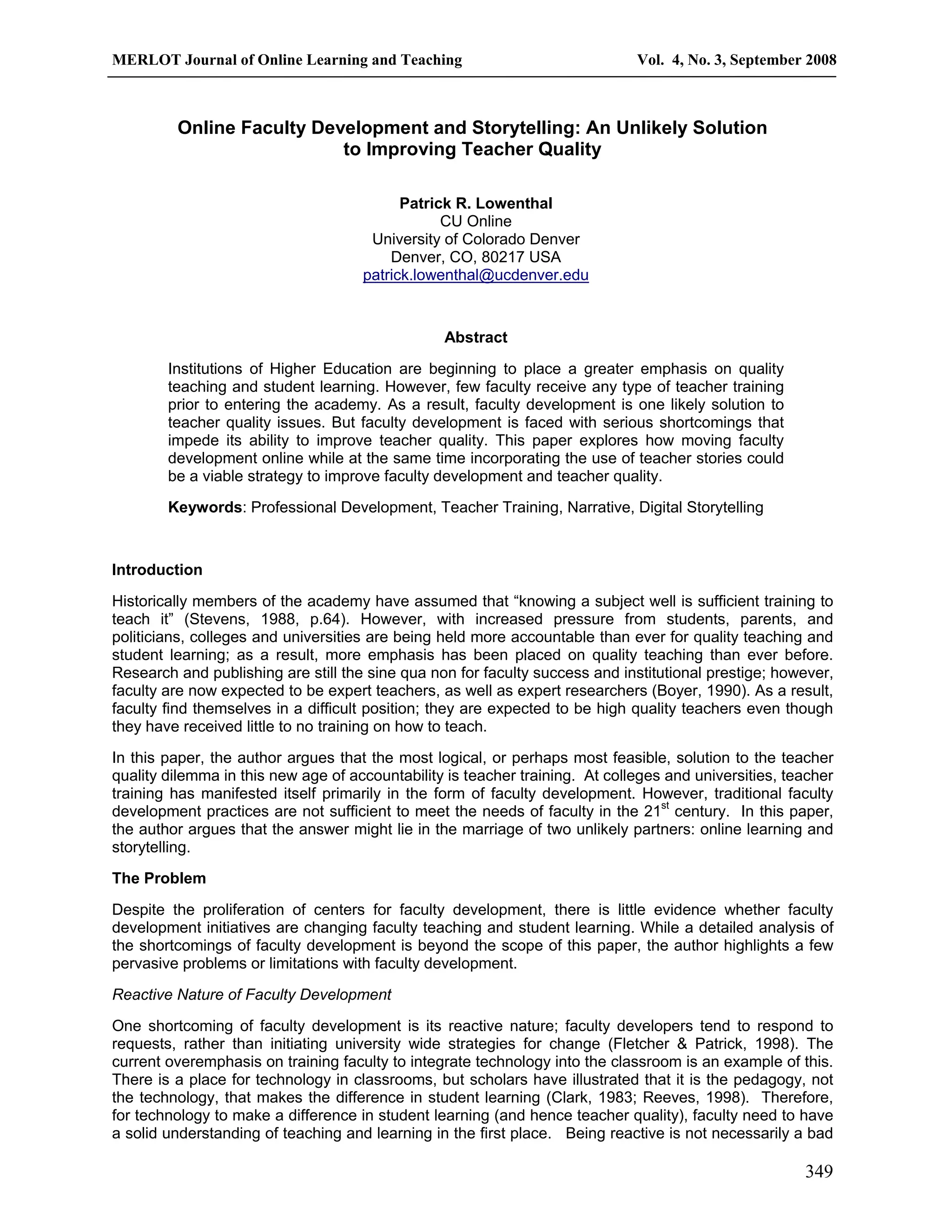
![MERLOT Journal of Online Learning and Teaching Vol. 4, No. 3, September 2008
thing. In fact, it is important to be responsive to faculty needs. For instance, Stevens (1988) explains that
faculty begin to “tinker” with their teaching as the result of either reflection about their teaching or
reacting to a situational problem in their teaching. However, there is a fine line between reacting to
trends or problems and providing faculty with relevant and timely support to improve instruction.
Changing the World in a Day
Another problem faculty developers struggle with is aligning their methodologies and epistemologies.
While research on learning espouses a learner-centered approach to learning and places high
importance on the transfer of learning (Bransford, Brown, & Cocking, 1999), typical faculty development
initiatives follow a teacher “in-service” approach of changing the world in a day. Often this is the only
successful way of attracting faculty to take time out of their schedule to attend faculty development in the
first place. While extended workshops are pedagogically appealing, they are expensive and seldom
attract enough faculty.
Attracting Faculty
Attracting faculty to attend faculty development remains a serious obstacle for faculty developers. In a
recent study, faculty claimed that lack of time and competing priorities were the two major obstacles to
attending faculty development (Stevens et al., 2005). To complicate matters, colleges and universities
are relying more and more on part-time faculty who often have even less formal training than full-time
faculty and even more competing priorities. In fact, Stevens et al. (2005) found, in a study they
conducted, that part-time faculty also claimed that lack of time and competing priorities was the number
one obstacle to attending faculty development. Therefore, for any faculty development initiative to
improve teacher quality it will not only have to deal with the issue of how to attract faculty but also
address attracting part-time faculty as well.
Changing Faculty Behavior
Perhaps the most daunting challenge faculty developer’s face is helping faculty change their teaching.
Even if colleges and universities required all faculty to attend faculty development to improve their
teaching, it would be a major challenge “helping teachers ‘unlearn’ the beliefs, values, assumptions, and
cultures” they have learned about teaching and learning in the academy (Dede, 2004, p. xii). Dede
(2004) explains further,
Altering deeply ingrained and strongly reinforced rituals of schooling takes more than an
informational interchange of the kind typical in conferences and ‘make and take’ professional
development. Intellectual, emotional, and social support is essential for ‘unlearning’ and for
transformational relearning that can lead to deeper behavior changes to create the next
generation of educational practices. (p. xii)
On top of all of this, faculty developers have to contend with the issue of competing priorities; namely,
why should faculty devote time to improving their teaching when promotion is typically tied more to
research?
Relevance, Context, and Transfer of Learning
Finally, there are issues of relevance, context, and transfer. Some attempts at improving teacher quality
have focused on isolating “best practices” or principles of good teaching. The most prominent work on
best practices come from the work of Chickering and Gamson (1987, 1999) and Marzano, Pickering, and
Pollock (2001). While lists of best practices are very popular, it is unclear whether they actually help
improve faculty teaching and student learning. Vrasidas and Glass (2004) and Cross (1998) have
challenged the trend of making a list of best practices by arguing that they oversimplify and
overcomplicate learning. However, lists like these are still plastered over countless faculty development
websites. Just as good teaching requires more than content knowledge, it too requires more than a
decontextualized bulleted list of best practices. Faculty cannot afford to forget the situated and specific
nature of learning (Lave & Wenger, 1991). Therefore, faculty development “must honor the complexity
of teachers’ practices …. [while allowing] participants to develop the reflective skills needed to gain new
insights into their pedagogical approaches and teaching practice” (Vrasidas & Glass, 2004, p. 4).
350](https://image.slidesharecdn.com/lowenthal0908-libre-141017143147-conversion-gate01/75/Online-faculty-development-and-storytelling-An-unlikely-solution-to-improving-teacher-quality-2-2048.jpg)
![MERLOT Journal of Online Learning and Teaching Vol. 4, No. 3, September 2008
Therefore, faculty development must be relevant to faculty’s individual needs; further, it must be situated
and contextual to help encourage the transfer of learning and changing of practice that needs to take
place. Without contextualizing and making things relevant, attracting faculty and hence helping support
the transfer of what faculty learn to their own classroom to improve their teaching is futile.
A Possible Solution
Given these and other shortcomings, faculty development might not appear to be the best place to start
to improve teacher quality. However, given the culture of the academy (e.g., requiring teacher training is
almost as unrealistic as systematically changing the reward structure), faculty development appears to
be one of the only realistic and viable solutions. There is no question that each of the previously
mentioned shortcomings must be addressed in part if any faculty development initiative or program is
going to be successful. However, the author argues in the following pages that online learning and
storytelling can help improve faculty development, which can ultimately improve teacher quality.
Online Learning
Online learning is drastically changing the face of higher education (Daugherty & Funke, 1998; Kezar &
Eckel, 2002). Online learning was expected to come and go like other fads in education, but enrollments
in online courses and programs continue to grow dramatically each year. In the fall of 2005, an
estimated 3.2 million students took at least one online course—800,000 more than the previous year
(Allen & Seaman, 2006). As a result, a great debate surrounding the quality of online learning has arisen.
An unintended consequence of this debate, as well as online learning’s continued popularity, is that
online learning is serving as a catalyst forcing colleges and universities to reconceptualize teaching and
learning (Daugherty & Funke, 1998; Duffy & Kirkley, 2004; Speck, 2002). While, it is the pedagogy, not
the technology, that makes the difference, different learning formats (e.g., the internet) have certain
affordances (e.g., Ryder & Wilson, 1996). Furthermore, Wiley (2002) eloquently argues that the online
learning environment influences how one teaches (i.e., teachers teach differently online than in the
classroom). Therefore, given the popularity and the possibilities of online learning with students, it is
surprising how little online learning—specifically facilitated asynchronous learning (the most popular form
of online learning in higher education)—has been used by colleges and universities for faculty
development.
Online Faculty Development
As the popularity and success of online learning continues, online faulty development is beginning to be
acknowledged as a viable alternative to face-to-face faculty development (Shea, Sherer, & Kristensen,
2002; Vrasidas & Glass, 2004). Putting faculty development online addresses some of the shortcomings
or limitations of faculty development. Also, as Vrasidas and Glass (2004) explain, ‘the demands of work
and family life for teachers [coupled with the rise in part-time faculty] . . . underline the need for
professional development activities that can be delivered anytime, anywhere” (p. 4).
Online faculty development is still in its infancy, though. However, when it has been used, it has been
used primarily to train faculty to use technology in some form—whether for online teaching or to integrate
technology into the classroom (Irani & Telg, 2002; Padgett & Conceicao-Runlee, 2000). This focus, falls
short of supporting the needs of all faculty members, and loses sight of one important issue: In this age
of accountability, faculty development’s primary objective should be to improve faculty teaching and
student learning, both in the classroom and online.
Using online faculty development that reflects an understanding of these issues and meets the needs of
the faculty at large is not an easy task; a few universities have begun to do this with mixed results
(Bellows & Danos, 2002; Wood et al., 1998). The experience of these institutions, as well as the
literature about online learning, suggests that putting faculty development online can address some of
the problems addressed earlier in this paper.
First, by using asynchronous communication or self-paced workshops online, all faculty can access
workshops at their convenience. Therefore, this format can help address attracting faculty to attend
workshops by eliminating issues of time and place. Second, by putting faculty development online,
faculty developers can increase “seat-time” by extending the workshop over time and avoid the problem
of changing the world in a day. Third, while online faculty development has not been shown to
351](https://image.slidesharecdn.com/lowenthal0908-libre-141017143147-conversion-gate01/75/Online-faculty-development-and-storytelling-An-unlikely-solution-to-improving-teacher-quality-3-2048.jpg)
![MERLOT Journal of Online Learning and Teaching Vol. 4, No. 3, September 2008
specifically address the challenge of changing faculty’s teaching, there is reason to believe it could. For
instance, Vrasidas and Glass (2004) remind us:
Students learn best when they are actively engaged in meaningful activities; when they
collaborate with peers, exchange ideas, and provide and receive peer feedback; when they
reflect critically on what they are doing; when they work on real-world, challenging, authentic
activities; when their work is constantly evaluated; and when they are intrinsically motivated. But
we tend to forget that teachers learn best in these ways too. (p. 2)
Thus, if online faculty development workshops were approached with these same strategies in mind,
there is reason to believe that in time faculty could begin to improve their practice.
But simply putting faculty development online will likely not be enough to improve teacher quality. For
instance, while eliminating issues of time and place by putting faculty development online helps address
part of the issue of attendance, it fails to address how the content, context, and relevance (or lack
thereof) of faculty development workshops also dissuade faculty attendance. Therefore, the author
argues in the remaining of this paper that the use of storytelling could be the missing ingredient needed
to help improve teacher quality with online faculty development.
The Power of Stories
Stories and storytelling might seem like a strange thing to pair with online learning to improve teacher
quality, but the power of stories to improve learning has been well documented (Abrahamson, 1998;
Connelly & Clandinin, 1994; McDrury & Alterio, 2003). While there is very little literature specifically on
the use of stories in faculty development, the literature on storytelling in education suggests that the
intentional use of stories and storytelling could greatly improve faculty development by addressing
among other things the issues of content, context, and relevance.
Before elaborating, it is important to highlight some of the reasons why people tell stories and why
faculty should tell more. The power of stories lies in their ability to build bridges of understanding
between individuals. Stories do this through using concrete examples rather than vague abstractions (or
bulleted distillations). Further, “story provides the framework and context for individuals to better
understand others by providing the key to their own experiences” (Abrahamson, 1998, p. 441). Stories
also have the ability to build connections with personal experience, which helps facilitate meaning
making and retention. For instance, Schank (1990) explains that,
We can tell people abstract rules of thumb [e.g., the “seven principles”] which we have derived
from prior experiences, but it is very difficult for other people to learn from these. We have
difficulty remembering such abstractions, but we can more easily remember a good story.
Stories give live to past experiences. Stories make the events in memory memorable to others
and to ourselves. (p. 10)
352
Further, Schank adds:
Thinking involves indexing . . . [and] the more information we are provided with about a situation,
the more places we can attach it to in memory . . . . Thus, a story is useful because it comes with
many indices . . . the more indices we have for a story that is being told, the more places it can
reside in memory . . . and hence the greater the learning. (p. 11)
This should not surprise anyone though. Story is perhaps the oldest form of education.
Storytelling and Faculty Development
Stories come to life during the social process of sharing or telling one’s story with others. The act of
telling a story creates a sense of community, which fosters collaboration, which then fosters meaning
making. Burk (2000) explains, “through oral storytelling, students may feel empowered as participants
rather than passive recipients of knowledge” (p. 7).
It is because of these reasons, and many more, that colleges and universities need to begin intentionally
integrating and leveraging the power of story and storytelling into faculty development. As Burk (2000)](https://image.slidesharecdn.com/lowenthal0908-libre-141017143147-conversion-gate01/75/Online-faculty-development-and-storytelling-An-unlikely-solution-to-improving-teacher-quality-4-2048.jpg)
